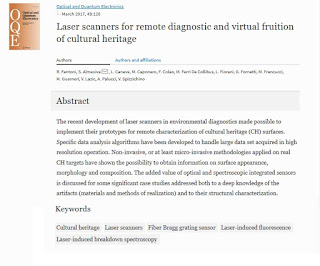News from the diagnostic world: laser scanners for remote diagnostic and virtual fruition of Cultural Heritage
Written by Melania Di Fazio
Translated by Sarah Fortunée Tabbakh
A few months ago, an interesting abstract on the development of laser scanners for the diagnostics and the use of cultural heritage (DOI 10.1007/s11082-017-0952-4) was published in Optical and Quantum Electronics (Springer Link).

The research group (ENEA of Frascati) is not new to the applied diagnostic to art. In this article they propose non-invasive technologies for the remote characterisation of historical and artistic surfaces. These analyses allow us to carry investigations without interacting directly with the surface under scrutiny: this is how, for example, we can analyse ceiling frescoes from the comfort of our ground without having to put up big and expensive scaffoldings.
The laser scanner prototypes described by the research team are:
• RGB-ITR (Red Green Blue Imaging Topological Radar)
• Hyperspectral LIF (Laser Induced Fluorescence)
• ILS (Integrated-Laser-Sensor)
The RGB-ITR provides us with colorimetric data, true-colour images and structural information of the studied surface, which allows us to create a perfect 3D model of the object. Thanks to this laser the ENEA researchers have realized accurate, extremely realistic and high resolution reconstructions of diverse painted surfaces (frescoes, oil paintings, metals, stone, ceramics, and other materials), which are fundamental in the use of the work of art and the accuracy of its study.
A monochromatic version of this prototype also exists for applications in immersion.
The LIF collects information from varnishes, consolidants, degradation products and pigments, projecting a spectre of fluorescence for every analysed point, thanks to the excitation caused by the UV laser. The instrument is created to carry out a linear scan, with a better resolution and a faster data collect. The energy released during the first scan is inferior to the threshold of damage to the painted surface, which is a significant characteristic. The obtained data is then translated into 2D monochromatic images and in fluorescent spectrums, one for each analysed pixel. The prototype can also capture reflectance spectrums when it is off.
Finally, the ILS is a prototype created at ENEA to carry out spectroscopic measurements (through LIF/Raman/LIBS), with a distance of 8 to 50 meters. It is self-powered and therefore is connected to wireless systems to operate even in critical conditions.
The innovative laser here defined have already been tested on various study cases described in the article, and have given excellent results.
For those who have access to the magazine, here is the link to the article:
To know more about the research centre ENEA of Frascati:
I hope I have aroused your curiosity: I will be waiting for you at the next update on the technologies applied to cultural goods.


Comments
Post a Comment